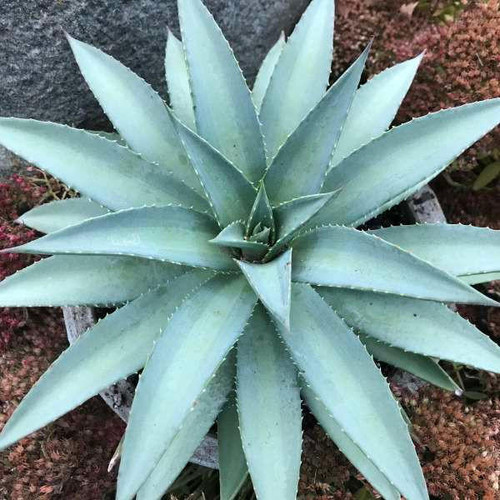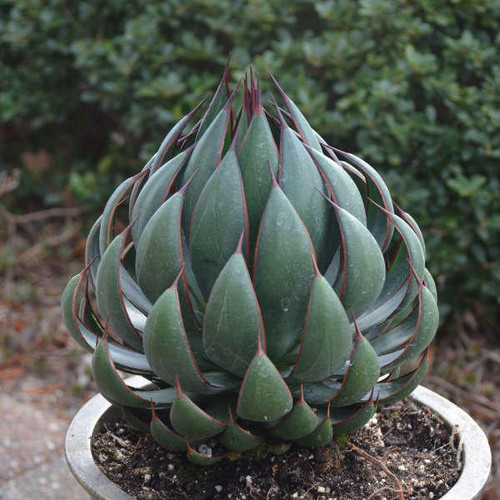Product Description
Mangave 'Frosted Elegance' PP32289 - MAD ABOUT MANGAVE Collection (72)ct Flat
Common Name: Mangave
A dreamy, ethereal looking succulent with unique coloration that you won't want to miss. Silvery blue arching leaves have soft green central bands. The glaucous color is thanks to the waxy film that covers the leaves. A beautiful addition to any garden or container.
Mangave is a relatively new phenomenon, an intergeneric cross of Manfreda x Agave. These rare hybrids combine the best of both worlds: the better growth rate and the interesting patterns of Manfreda, and the habit and refinement of Agave. We are very excited (shall we say mad?) about our new hybrids from Walters Gardens hybridizing.
Mangave is a tender perennial or "temperennial" succulent plant that grows best in full sun. Plant in well-drained, dry to average soil in containers just slightly wider than the width of the rosette or plant directly in the ground. In summer when the plants are actively growing, they appreciate a bit of supplemental watering and half-strength fertilizer. They should be grown dry in winter. Mangave is a slower grower, so it will not quickly overtake the space it is allotted in the landscape.
Height: 6.0-8.0 Inches
Spread: 12.0-14.0 Inches
Hardiness Zones: 9,10,11
Foliage Color: Blue shades
Full Sun (> 6 hrs. Direct Sun)
Low Water Needs
Poor to Average Soil Quality
Deer and Rabbit Resistant
Growth Rate: Slow
Container, Drought Tolerant, Attractive Foliage, Small, Specimen, Focal Point, Native to North America
Mangave 'Frosted Elegance'
Mangave 'Frosted Elegance' is a hybrid succulent that combines the best features of Manfreda and Agave, belonging to the "Mad About Mangave®" collection. This stunning plant boasts icy-blue foliage with a soft green center, making it a standout in any garden. With its unique appearance, heat tolerance, and compact habit, Mangave 'Frosted Elegance' has become a favorite among gardening enthusiasts. What sets this succulent apart is its fast growth rate compared to Agave, its user-friendliness due to softer spines, and its suitability for both indoor and outdoor growth.
Mangave 'Frosted Elegance' is not naturally occurring; it is a cultivated hybrid. Its parent plants, Agave and Manfreda, are native to the arid and semi-arid regions of North and Central America. This captivating succulent forms a striking rosette of broad, arching leaves, growing in a symmetrical, compact manner. Its foliage is its most distinctive feature, displaying a frosty, silvery-green hue with soft green central bands. The leaves have small, soft teeth along the margins, adding a delicate texture. Mangave 'Frosted Elegance' typically reaches a height of 6 to 8 inches and spreads 12 to 14 inches wide. It grows at a fast rate and can be expected to live for approximately 5 years.
Mangave inherits the best qualities of both parent plants. Agave lends durability and large, architectural form, while Manfreda contributes unique colors, patterns, and a faster growth rate. The blooming season for 'Frosted Elegance' is spring and summer, with flowers ranging from white to lavender in color.
Growing and Caring for Mangave 'Frosted Elegance' With its easy-care requirements, Mangave 'Frosted Elegance' is a great choice for gardeners of all levels. This succulent thrives in warm climates and full sun exposure. Here is a detailed guide on how to grow and care for this beautiful succulent:
- Light Mangave 'Frosted Elegance' needs at least 6 hours of direct sunlight daily for optimal growth. If growing indoors, place it near a south-facing window to ensure it receives adequate sunlight.
- Soil Well-draining soil is crucial for Mangave 'Frosted Elegance'. A cactus or succulent mix is ideal, and adding sand or perlite can further improve drainage.
- Water Water sparingly, allowing the soil to dry completely between waterings. Reduce watering during the winter months when the plant is dormant.
- Fertilizer Feed with a diluted, balanced fertilizer once a month during the growing season (spring and summer). Avoid over-fertilizing, as this can lead to leggy growth.
- Pruning Mangave 'Frosted Elegance' requires minimal pruning. Simply remove any dead or damaged leaves as needed.
- Pests and Diseases This succulent is generally pest-resistant. However, watch out for mealybugs or scale insects. Overwatering can lead to root rot, so ensure proper drainage.
- Repotting When repotting Mangave 'Frosted Elegance', choose a container slightly larger than the root ball to allow for growth. Terracotta pots are recommended as they allow excess moisture to evaporate. Repot every 1-2 years to refresh the soil and ensure proper drainage.
- Winter Care If growing Mangave 'Frosted Elegance' outdoors in a colder climate (below USDA zone 9), bring it indoors before the first frost to protect it from freezing temperatures. Place it in a well-lit area to prevent stretching and maintain a temperature above 60°F (15°C).
Ideal Climate and Soil Conditions Mangave 'Frosted Elegance' is hardy in USDA zones 9 to 11. It prefers warm climates with temperatures between 60-75°F (15-24°C). In colder zones, it can be grown as an annual or brought indoors for the winter. This plant will not tolerate a hard frost.
This succulent thrives in dry to average, well-draining soil. It is drought-tolerant and can survive prolonged periods without rainfall due to its ability to store water in its thick leaves. It is also resistant to deer and rabbits.
Potential Uses Mangave 'Frosted Elegance' is primarily used as an ornamental plant due to its unique and attractive appearance. It is an excellent choice for:
- Rock gardens
- Succulent gardens
- Borders
- Containers
- Xeriscaping
- Water-wise gardens
Its compact size makes it suitable for smaller spaces, and it can also be used as a houseplant.
Toxicity Like many members of the Agave family, Mangave 'Frosted Elegance' contains sap that can be irritating to the skin and mucous membranes. It is advisable to handle the plant with care, wearing gloves to avoid contact with the sap. If ingested, it can be harmful to pets.
Propagation
Mangave 'Frosted Elegance' can be propagated through offsets, also known as "pups," that form around the base of the plant. These offsets can be carefully separated and potted up to create new plants. The best time for propagation is during the warmer months when temperatures are around 70-80°F.
Mangave 'Frosted Elegance' is a captivating succulent that adds a touch of elegance to any setting. Its unique foliage, low-maintenance nature, and versatility make it an excellent choice for both novice and experienced gardeners. By following the growing and care tips outlined, you can enjoy the beauty of Mangave 'Frosted Elegance' in your own garden or home.
Other Details
The most important part of the plant is its root system. Healthy roots are the foundation of a healthy, vibrant plant. The type of plug container used is based on the specific needs of the plants. Perennials offered as bare root traditionally perform better when planted as bare root.Planted in a specialized mix, potted plants have well established root systems. Top growth stage will vary depending on the current life cycle and time of year when shipped. In Winter and early Spring dormant plants may be shipped. Dormant plants may be planted right away, even before the last frost date.
Most bare root varieties are field grown for at least one season, though Hemerocallis and Hosta are grown for two seasons. The bulk of the soil is removed during the harvesting process and the tops of most varieties are trimmed back to the crown. They are graded, packed in shredded aspen or sphagnum moss and stored in freezers until ready to be shipped.
See our Container Sizes and Bare Root Perennials pages for more information.
Plant information and care is provided in the Overview section, Plant Genus Page and general information is provided in the Planting Care & Guides. Additional questions can be asked on each Plant page.
Plant Spacing: Using the maximum mature spread or width of a plant to guide spacing, ensures space to grow to full size. To fill an area sooner, plant them closer together. Just remember, future thinning or transplanting may be needed.
Water: Keep a close eye on newly planted perennials, especially throughout the first growing year. Most early plant loss is due to too much or too little water!






